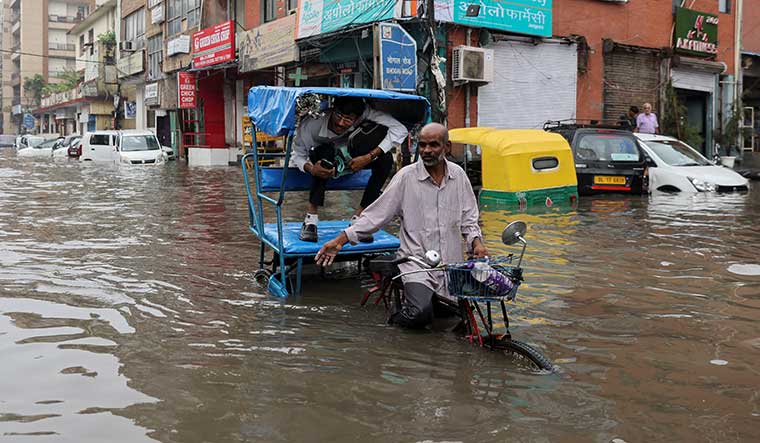BUYING A CAR these days is not just about the brand or the mileage. It is increasingly about which variant to buy―petrol, diesel, CNG or the latest craze, the electric and the hybrid models. The world has realised that opting for an electric vehicle is yet another step forward in the fight against climate change, which was set out eight years ago at the Paris agreement.
Climate change and global warming are clearly at a tipping point. Unrelenting floods in Asia, sweltering heat in Europe, terrible drought in the Horn of Africa and wildfires in North America are all harbingers of the deadly reality. The 2015 Paris plan is to keep the rise in global temperature below at least 2 degrees centigrade, the ideal level being 1.5 degrees. The preferred method to achieve this goal is a structural shift from fossil fuels to renewable energy. That costs money.
A recent report by the International Renewable Energy Agency (IRENA) says the transition requires at least $4.4 trillion annually. It is here that the G20 countries―which together account for more than 85 per cent of the global GDP―have to play a pivotal role. Mapping out an ambitious goal “to triple renewable energy capacity globally… by 2030”, a hallmark of the G20 Delhi declaration, the emphasis is on reforming the global financial institutions and the debt structuring system. The aim is to make funds affordable and available in a fair manner so that the developing nations can meet their climate obligations. To put up a robust fight against climate change is, therefore, also about the availability of low-cost financing to combat the rising heat and deteriorating climatic conditions, particularly against the backdrop of rising interest rates.
Arunabha Ghosh, CEO of the Council on Energy, Environment and Water, says India alone will require over $10 trillion in investments to reach net zero by 2070. “The New Delhi declaration supports the imperative of securing trillions of dollars to benefit the billions of people in the Global South through the Green Development Pact. Our research shows that the role of multilateral development banks is crucial, and the declaration highlights blended finance and risk-sharing mechanisms,” he says. “If we can devise methods to consolidate projects and narrow the gap between the perceived and actual risk of investing in emerging markets, we can reduce the cost of financing and encourage private investment in projects that focus on mitigation, as well as those that do so on adaptation efforts.”
The efforts to use renewable and sustainable forms of energy are being taken forward on multiple fronts. With solar energy systems and onshore wind technologies having achieved considerable maturity and competitiveness, newer verticals like offshore wind, hydrogen electrolysers (an apparatus that produces hydrogen) and energy storage are emerging, especially in the developing world. Meeting the high costs is a challenge. The greater usage of these new verticals is essential to move to the next phase of energy transition.
Bhupinder S. Bhalla, secretary, ministry of new and renewable energy, says access to low-cost capital will play a significant role in financing energy transition projects for G20 countries and beyond, while collaboration between public and private sectors will help catalyse institutional capital flows. “To achieve the 1.5 degrees centigrade goal of the Paris agreement, the overall share of renewable energy in the primary energy mix will need to rise to as much as 75 per cent, requiring an annual investment of over $4.4 trillion. To enable an energy system aligned with this target, investment in energy transition technologies needs to scale up considerably, complemented by a simultaneous redirection of investment away from fossil fuels.”
In the Indian case, low-cost climate finances make for a more compelling argument. Already the world’s third-biggest energy guzzler, India will see its energy requirements going up considerably. The International Energy Agency says India’s demand will see the highest jump in the next two decades.
The G20 declaration of September 9 called for “an ambitious, transparent and trackable New Collective Quantified Goal (NCQG) of climate finance in 2024, from a floor of $100 billion a year, taking into account the needs and priorities of developing countries in fulfilling the objective of the United Nations Framework Convention on Climate Change and the implementation of the Paris agreement”.
The good news is that the promise of the developed countries of mobilising $100 billion a year for the developing countries may be met for the first time this year itself. But there are also questions. Vibhuti Garg, director, South Asia, Institute for Energy Economics and Financial Analysis, says there is no further commitment on increasing the availability of finance to developing countries beyond $100 billion. “The net zero target needs much higher investment and if that commitment is not enhanced, it will be difficult for countries in the Global South to achieve their climate goals.” She says the role of blended finance and multilateral development banks needs to be further fleshed out and also the issues on green taxonomy.
The Delhi declaration underlined the vital role of private climate finance in supplementing public funds and encouraging the development of financing mechanisms. According to the IRENA report, the bulk of the investment will need to focus on renewable energy, energy efficiency, electrification and enabling infrastructure. It says capital needs to be mobilised urgently from domestic and international resources of the private sector.
To be fair, India has not done badly. The IRENA report says India’s renewable energy sector has seen unprecedented growth. The country ranked third on the Renewable Energy Attractiveness Index in 2021, and its solar and wind power base is the fourth largest in the world. “The country’s capacities are some of the fastest growing among the top five countries promoting and advancing renewable energy,” says the report. That is a great achievement, but there is still a long way to go.


